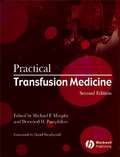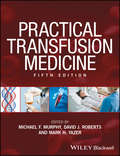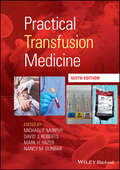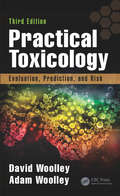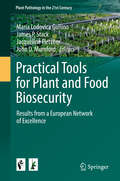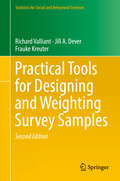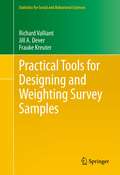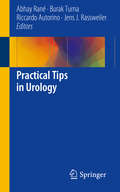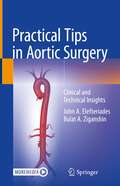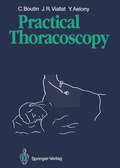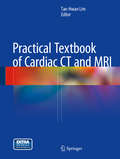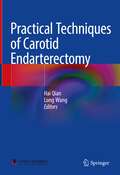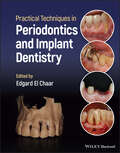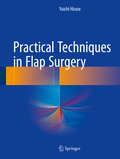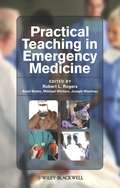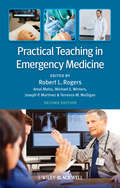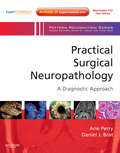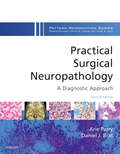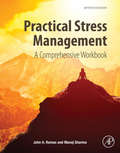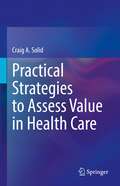- Table View
- List View
Practical Transfusion Medicine
by Michael F. Murphy Derwood H. Pamphilon David J. WeatherallEssential practical manual for all those working in modern transfusion medicine Why Buy This Book? Concise and 'user friendly’ guide to transfusion medicine Provides guidance for everyday clinical questions Revised and updated throughout to reflect rapid developing areas Scope broadened by including experts from the USA
Practical Transfusion Medicine
by Michael F. Murphy David J. Roberts Mark H. YazerThe fifth edition of this practical textbook on transfusion medicine has been thoroughly revised with the latest in scientific and technological developments and edited by a leading team of international expert haematologists, including new co-editor Mark H. Yazer MD. A succinct and user-friendly resource of transfusion medicine for clinicians, scientists and trainees with key points, charts and algorithms Discusses practice in blood centres and hospitals including regulatory aspects, transfusion safety, production and storage, donor care, and blood transfusion in a global context Coverage of cellular and tissue therapies and organ transplantation including stem cell collection and haematopoietic stem cell processing and storage Review of the development of the evidence-base for transfusion medicine Content on the clinical practice for transfusion and alternatives to transfusion
Practical Transfusion Medicine
by Michael F. Murphy David J. Roberts Mark H. YazerThe fifth edition of this practical textbook on transfusion medicine has been thoroughly revised with the latest in scientific and technological developments and edited by a leading team of international expert haematologists, including new co-editor Mark H. Yazer MD. A succinct and user-friendly resource of transfusion medicine for clinicians, scientists and trainees with key points, charts and algorithms Discusses practice in blood centres and hospitals including regulatory aspects, transfusion safety, production and storage, donor care, and blood transfusion in a global context Coverage of cellular and tissue therapies and organ transplantation including stem cell collection and haematopoietic stem cell processing and storage Review of the development of the evidence-base for transfusion medicine Content on the clinical practice for transfusion and alternatives to transfusion
Practical Transfusion Medicine
by Michael F. Murphy David J. Roberts Mark H. Yazer Nancy M. DunbarPractical Transfusion Medicine Practical Transfusion Medicine, Sixth Edition The pace of change in transfusion medicine is relentless, with new scientific and technological developments and continuing efforts to improve transfusion practice. This sixth edition of Practical Transfusion Medicine has been updated significantly to reflect the rapid changes in transfusion medicine since the fifth edition was published in 2017. The primary purpose of this edition remains the same as the first: to provide a comprehensive guide to transfusion medicine. This book contains more depth of information than standard handbooks on transfusion medicine, whilst being more concise and approachable than a standard reference text. This book covers the principles of transfusion medicine, the complications of transfusion, practice in blood centres and hospitals and clinical transfusion practice. This sixth edition includes a new section on patient blood management, cellular and tissue therapy, organ transplantation and the development of the evidence base for transfusion. It also features a new chapter on transfusion-associated circulatory overload to underline its importance as a complication of transfusion, and a reconfiguration of the section on clinical transfusion practice to allow consideration of the transfusion management of medical, surgical and haematology patients with and without bleeding. This sixth edition of Practical Transfusion Medicine provides accessible and comprehensive coverage of the field of transfusion medicine. It is a standalone text that will be useful to clinical and scientific staff: not only for trainees who require an overview of the field, but also for established practitioners who are involved in some aspect of transfusion medicine and require a comprehensive, accessible reference book.
Practical Transfusion Medicine
by Michael F. Murphy David J. Roberts Mark H. Yazer Nancy M. DunbarPractical Transfusion Medicine Practical Transfusion Medicine, Sixth Edition The pace of change in transfusion medicine is relentless, with new scientific and technological developments and continuing efforts to improve transfusion practice. This sixth edition of Practical Transfusion Medicine has been updated significantly to reflect the rapid changes in transfusion medicine since the fifth edition was published in 2017. The primary purpose of this edition remains the same as the first: to provide a comprehensive guide to transfusion medicine. This book contains more depth of information than standard handbooks on transfusion medicine, whilst being more concise and approachable than a standard reference text. This book covers the principles of transfusion medicine, the complications of transfusion, practice in blood centres and hospitals and clinical transfusion practice. This sixth edition includes a new section on patient blood management, cellular and tissue therapy, organ transplantation and the development of the evidence base for transfusion. It also features a new chapter on transfusion-associated circulatory overload to underline its importance as a complication of transfusion, and a reconfiguration of the section on clinical transfusion practice to allow consideration of the transfusion management of medical, surgical and haematology patients with and without bleeding. This sixth edition of Practical Transfusion Medicine provides accessible and comprehensive coverage of the field of transfusion medicine. It is a standalone text that will be useful to clinical and scientific staff: not only for trainees who require an overview of the field, but also for established practitioners who are involved in some aspect of transfusion medicine and require a comprehensive, accessible reference book.
Practical Toxicology: Evaluation, Prediction, and Risk, Third Edition
by Adam Woolley David WoolleyPractical Toxicology: Evaluation, Prediction, and Risk, Third Edition shows how to conduct a program of safety evaluation and testing and then to interpret and apply the resulting data and information in the real world, beginning with the basic concepts in toxicology and progressing to the interpretation of the resulting data. Revised and updated chapters on risk assessment guide the reader to setting the foundations necessary for submission to regulatory authorities. In addition, a new chapter in the book reviews the errors in toxicology, mistakes, misuse, mismanagement, and misunderstanding with a view to avoiding these in the future. New Chapters in the Third Edition: Toxicology in silico Errors in Toxicology Safety Assessment of Extractables and Leachables. This new edition follows a practical sequence from introducing the basics of toxicology (including the vital concept of normality in controls) to describing a test program and then interpreting the data and translating that to risk assessment that can be used in a number of real world situations where safety and secure risk assessment are essential. Although written primarily from the perspective of pharmaceutical development, the test designs and toxicological problems encountered in that field are entirely relevant to those with other classes of chemicals, the only difference being the regulatory context. Toxicology is an international discipline and the book has been written to take into account some of the differences in regulatory nuance between the main regions of the world. Completely revised and written in an easily accessible style, the text address several audiences—from students and post-graduates coming to the subject for the first time to established professionals who find themselves needing to learn about toxicology, toxicity testing, interpretation of the results, and risk assessment. It is intended primarily as a textbook, with case studies and information on where to go to ask questions, but can also be used as a practical reference book. It covers all the basics of toxicology and the main aspects of safety evaluation testing and risk assessment while reviewing critically the current state of the discipline. It also provides a foundation for those seeking registration or certification.
Practical Toxicology: Evaluation, Prediction, and Risk, Third Edition
by David Woolley Adam WoolleyPractical Toxicology: Evaluation, Prediction, and Risk, Third Edition shows how to conduct a program of safety evaluation and testing and then to interpret and apply the resulting data and information in the real world, beginning with the basic concepts in toxicology and progressing to the interpretation of the resulting data. Revised and updated chapters on risk assessment guide the reader to setting the foundations necessary for submission to regulatory authorities. In addition, a new chapter in the book reviews the errors in toxicology, mistakes, misuse, mismanagement, and misunderstanding with a view to avoiding these in the future. New Chapters in the Third Edition: Toxicology in silico Errors in Toxicology Safety Assessment of Extractables and Leachables. This new edition follows a practical sequence from introducing the basics of toxicology (including the vital concept of normality in controls) to describing a test program and then interpreting the data and translating that to risk assessment that can be used in a number of real world situations where safety and secure risk assessment are essential. Although written primarily from the perspective of pharmaceutical development, the test designs and toxicological problems encountered in that field are entirely relevant to those with other classes of chemicals, the only difference being the regulatory context. Toxicology is an international discipline and the book has been written to take into account some of the differences in regulatory nuance between the main regions of the world. Completely revised and written in an easily accessible style, the text address several audiences—from students and post-graduates coming to the subject for the first time to established professionals who find themselves needing to learn about toxicology, toxicity testing, interpretation of the results, and risk assessment. It is intended primarily as a textbook, with case studies and information on where to go to ask questions, but can also be used as a practical reference book. It covers all the basics of toxicology and the main aspects of safety evaluation testing and risk assessment while reviewing critically the current state of the discipline. It also provides a foundation for those seeking registration or certification.
Practical Tools for Plant and Food Biosecurity: Results from a European Network of Excellence (Plant Pathology in the 21st Century #8)
by Maria Lodovica Gullino James P. Stack Jacqueline Fletcher John D. MumfordThis book is based on EU-funded project PLANTFOODSEC, covering intentional and unintentional threats to plant biosecurity and to food safety areas.Biosecurity is a strategic and integrated approach for analysing and managing relevant risks to human, animal and plant life and health, and associated risks to the environment. Interest in biosecurity has risen considerably over the last decade in parallel with the increasing trade in food and plant and animal products; higher levels of international travel; new outbreaks of transboundary diseases.Although most diseases outbreaks have natural causes or are the result of inadvertent introductions of pathogens through human activities, the risk of a deliberate introduction of a high consequence plant pathogen cannot be excluded. Vigilance is required to identify, prevent and manage new and emerging issues that could impact on production capacity, plant biosecurity or food safety and food chain resilience.
Practical Tools for Designing and Weighting Survey Samples (Statistics for Social and Behavioral Sciences)
by Richard Valliant Jill A. Dever Frauke KreuterThe goal of this book is to put an array of tools at the fingertips of students, practitioners, and researchers by explaining approaches long used by survey statisticians, illustrating how existing software can be used to solve survey problems, and developing some specialized software where needed. This volume serves at least three audiences: (1) students of applied sampling techniques; 2) practicing survey statisticians applying concepts learned in theoretical or applied sampling courses; and (3) social scientists and other survey practitioners who design, select, and weight survey samples. The text thoroughly covers fundamental aspects of survey sampling, such as sample size calculation (with examples for both single- and multi-stage sample design) and weight computation, accompanied by software examples to facilitate implementation. Features include step-by-step instructions for calculating survey weights, extensive real-world examples and applications, and representative programming code in R, SAS, and other packages. Since the publication of the first edition in 2013, there have been important developments in making inferences from nonprobability samples, in address-based sampling (ABS), and in the application of machine learning techniques for survey estimation. New to this revised and expanded edition: • Details on new functions in the PracTools package • Additional machine learning methods to form weighting classes • New coverage of nonlinear optimization algorithms for sample allocation • Reflecting effects of multiple weighting steps (nonresponse and calibration) on standard errors • A new chapter on nonprobability sampling • Additional examples, exercises, and updated references throughout Richard Valliant, PhD, is Research Professor Emeritus at the Institute for Social Research at the University of Michigan and at the Joint Program in Survey Methodology at the University of Maryland. He is a Fellow of the American Statistical Association, an elected member of the International Statistical Institute, and has been an Associate Editor of the Journal of the American Statistical Association, Journal of Official Statistics, and Survey Methodology. Jill A. Dever, PhD, is Senior Research Statistician at RTI International in Washington, DC. She is a Fellow of the American Statistical Association, Associate Editor for Survey Methodology and the Journal of Official Statistics, and an Assistant Research Professor in the Joint Program in Survey Methodology at the University of Maryland. She has served on several panels for the National Academy of Sciences and as a task force member for the American Association of Public Opinion Research’s report on nonprobability sampling. Frauke Kreuter, PhD, is Professor and Director of the Joint Program in Survey Methodology at the University of Maryland, Professor of Statistics and Methodology at the University of Mannheim, and Head of the Statistical Methods Research Department at the Institute for Employment Research (IAB) in Nürnberg, Germany. She is a Fellow of the American Statistical Association and has been Associate Editor of the Journal of the Royal Statistical Society, Journal of Official Statistics, Sociological Methods and Research, Survey Research Methods, Public Opinion Quarterly, American Sociological Review, and the Stata Journal. She is founder of the International Program for Survey and Data Science and co-founder of the Coleridge Initiative.
Practical Tools for Designing and Weighting Survey Samples (Statistics for Social and Behavioral Sciences #51)
by Richard Valliant Jill A. Dever Frauke KreuterSurvey sampling is fundamentally an applied field. The goal in this book is to put an array of tools at the fingertips of practitioners by explaining approaches long used by survey statisticians, illustrating how existing software can be used to solve survey problems, and developing some specialized software where needed. This book serves at least three audiences: (1) Students seeking a more in-depth understanding of applied sampling either through a second semester-long course or by way of a supplementary reference; (2) Survey statisticians searching for practical guidance on how to apply concepts learned in theoretical or applied sampling courses; and (3) Social scientists and other survey practitioners who desire insight into the statistical thinking and steps taken to design, select, and weight random survey samples. Several survey data sets are used to illustrate how to design samples, to make estimates from complex surveys for use in optimizing the sample allocation, and to calculate weights. Realistic survey projects are used to demonstrate the challenges and provide a context for the solutions. The book covers several topics that either are not included or are dealt with in a limited way in other texts. These areas include: sample size computations for multistage designs; power calculations related to surveys; mathematical programming for sample allocation in a multi-criteria optimization setting; nuts and bolts of area probability sampling; multiphase designs; quality control of survey operations; and statistical software for survey sampling and estimation. An associated R package, PracTools, contains a number of specialized functions for sample size and other calculations. The data sets used in the book are also available in PracTools, so that the reader may replicate the examples or perform further analyses.
Practical Tips in Urology
by Abhay Rané Burak Turna Riccardo Autorino Jens J. RassweilerPractical Tips in Urology is a compact, illustrated reference which provides the reader with practical tips and advice in managing day-to-day urological issues encountered in a clinical setting. This book draws on practical experience and offers useful information that is often lacking in didactic textbooks of urology and in journal articles. Practical Tips in Urology provides tips in dealing with urological emergencies, elective surgery and common outpatient consultation problems, among other things. Written by experts in the field, Practical Tips in Urology is key reading for all practicing urologists and residents in training.
Practical Tips in Aortic Surgery: Clinical and Technical Insights
by John A. Elefteriades Bulat A. ZiganshinThis textbook provides practical tips on the conduct of aortic surgery, from the aortic valve to the iliac arteries. It is organized as a series of Plates, each with a key central illustration, followed by bullet items of accompanying explanatory text. The accompanying text concentrates on specific, critical “do’s and don’ts” that promote and enhance patient safety. Chapters include dozens of color illustrations by one of the nation’s premier medical illustrators, along with selected classic “pen and ink” line drawings. Each central illustration is accompanied by additional secondary figures interspersed at intervals within the accompanying text. Each “practical tip” has an accompanying short (15-30 second) video demonstrating vividly the specific didactic point being made in each Plate. Chapters provide Q&A sections, to promote an interactive feel and experience. The textbook shares practical, potentially life-saving tips—gleaned from over three decades of experience in thousands of aortic operations—regarding virtually every standard operation that arises in aortic surgery. Practical Tips in Aortic Surgery will be an essential resource for surgeons and trainees at all levels of experience: residents and fellows, surgical physician assistants, surgical nurses and technicians, and medical students. The book directly targets two surgical specialties: Cardiac Surgery and Vascular Surgery
Practical Thoracoscopy
by Christian Boutin Jean R. Viallat Yossef AelonyDiseases of the pleura such as effusion, thickening, or pneumothorax are frequently encountered in the practice of medicine. Practical Thoracoscopy presents an encyclopedic approach to the use of thoracoscopy in the diag nosis and treatment of patients with pleural disease. After an initial chapter on the history of thoracoscopy, the next three chapters of the book are devoted to the general technique of performing thoracoscopy, a topic on which the team of Dr. Boutin and his colleagues write with ample experience. In these chapters they provide detailed de scriptions of how to perform the procedure and discuss the pros and the cons of the different approaches and the different equipment available. The following chapter discusses the complications of the procedure. The next chapter discusses the role of thoracoscopy in diagnosing pleu ral effusions. My own opinion here is in general that, as long as well trained personnel are available, thoracoscopy is preferable to open pleural biopsy, because it is associated with less morbidity and mortality and can be done if necessary under local anesthesia. The following chapter is directed at using to thoracoscopy to facilitate pleurodesis for chronic pleural effusions. With Boutin's method, talc pou drage is performed during thoracoscopy, and certainly, if a thoracoscopy is used to establish the diagnosis of a malignant pleural effusion, it is appro priate to attempt to induce a pleurodesis with talc at the time of the diag nostic procedure.
Practical Textbook of Cardiac CT and MRI
by Tae-Hwan LimThis up-to-date textbook comprehensively reviews all aspects of cardiac CT and MRI and demonstrates the value of these techniques in clinical practice. A wide range of applications are considered, including imaging of atherosclerotic and non-atherosclerotic coronary artery disease, coronary revascularization, ischemic heart disease, non-ischemic cardiomyopathy, valvular heart disease, cardiac tumors, and pericardial disease. The numerous high-quality images illustrate how to interpret cardiac CT and MRI correctly for the purposes of diagnosis, treatment planning, and follow-up. Helpful summarizing sections in every chapter will facilitate rapid retrieval of information. This book will be of great value to radiologists and cardiologists seeking a reliable guide to the optimal use of cardiac CT and MRI in real clinical situations.An additional feature is the provision of QR codes allowing internet access to references, further figures, and motion pictures. The reader will be able to enjoy this book using a smartphone or tablet PC.
Practical Techniques of Carotid Endarterectomy
by Hai Qian Long WangThis book addresses multiple principles of carotid endarterectomy in terms of cervical anatomy, surgical techniques, practical cases and frequent questions stemming from clinical practice. Carotid endarterectomy (CEA) is an effective way to the treatment of carotid artery stenosis, which significantly reduce the risk of stroke. This book covers the key concepts and common question in CEA. It is a practical book focusing on basic surgical technical techniques, but not covers controversial issues.
Practical Techniques in Periodontics and Implant Dentistry
by Edgard El ChaarPractical Techniques in Periodontics and Implant Dentistry A quick reference to essential techniques in periodontics and implant dentistry designed for clinical use In Practical Techniques in Periodontics and Implant Dentistry, distinguished periodontist Dr. Edgard El Chaar delivers a comprehensive quick reference to key information on periodontics and implant dentistry. The book takes a concise and technique-based approach to the subject, a design that allows clinicians to rapidly find and apply important information in seeing cases. It provides brief chapters with plentiful and instructive images. This manual is precise, offers quick access to the fundamentals of each of the pertinent topics in the field, and provides practitioners the ability to refer to an authoritative and straightforward resource in their daily clinical practice. It includes radiographs, histological images, clinical photographs, and line drawings. Readers will also find: A thorough introduction to the anatomy and physiology of the periodontium, including an overview of gingival tissue, embryonic development, and soft tissue physiology Comprehensive explorations of wound healing, pathology of periodontal disease, and oral medicine and pathology In-depth discussions of patient examination and initial therapy, surgical anatomy and local anesthesia, and suturing techniques Fulsome presentations of osseous surgery, clinical crown lengthening, and the principles of implant dentistry Perfect for general practitioners, periodontists, and implant dentists, Practical Techniques in Periodontics and Implant Dentistry will also earn a place in the libraries of dental students with an interest in periodontics.
Practical Techniques in Periodontics and Implant Dentistry
by Edgard El ChaarPractical Techniques in Periodontics and Implant Dentistry A quick reference to essential techniques in periodontics and implant dentistry designed for clinical use In Practical Techniques in Periodontics and Implant Dentistry, distinguished periodontist Dr. Edgard El Chaar delivers a comprehensive quick reference to key information on periodontics and implant dentistry. The book takes a concise and technique-based approach to the subject, a design that allows clinicians to rapidly find and apply important information in seeing cases. It provides brief chapters with plentiful and instructive images. This manual is precise, offers quick access to the fundamentals of each of the pertinent topics in the field, and provides practitioners the ability to refer to an authoritative and straightforward resource in their daily clinical practice. It includes radiographs, histological images, clinical photographs, and line drawings. Readers will also find: A thorough introduction to the anatomy and physiology of the periodontium, including an overview of gingival tissue, embryonic development, and soft tissue physiology Comprehensive explorations of wound healing, pathology of periodontal disease, and oral medicine and pathology In-depth discussions of patient examination and initial therapy, surgical anatomy and local anesthesia, and suturing techniques Fulsome presentations of osseous surgery, clinical crown lengthening, and the principles of implant dentistry Perfect for general practitioners, periodontists, and implant dentists, Practical Techniques in Periodontics and Implant Dentistry will also earn a place in the libraries of dental students with an interest in periodontics.
Practical Techniques in Flap Surgery
by Yuichi HiraseThis book was written for orthopedic and plastic surgeons who wish to learn about reconstructive surgery of the extremities and trunk. For reconstructions of the extremities and trunk, surgeons need information on both orthopedic and plastic surgery. However, orthopedic surgeons are generally not familiar with the reconstruction of soft tissue, and plastic surgeons have little experience with osseo-tendinous system reconstructions. For those reasons, there is a definite need for a book detailing both fields of surgery. Because many existing books focus on only the type of flap, it is difficult for doctors to distinguish which flap is best for their patients in need of reconstructive surgery. In this book, chapters are based not on the flap but the injury site. In the each chapter, pitfalls and candidate flaps are described for the reconstruction of each site. Additionally, the operative steps are explained with the help of numerous high-quality photos, offering a unique valuable resource for orthopedic and plastic surgeons faced with these challenges.
Practical Teaching in Emergency Medicine
by Robert L. Rogers Amal Mattu Michael E. Winters Joseph P. MartinezInherent to the teaching and practice of emergency medicine are specific challenges not found in other specialties - the unknowns of the emergency department, the need to identify life- and limb-threatening conditions, the pressure to solve problems and find solutions quickly, and the orchestration of clinical specialists and ancillary services. Because of these unique demands, books written by clinicians from other disciplines, that extrapolate their information from other specialties, aren’t always suitable references for teachers of emergency medicine. This book is different – it shows how to incorporate effective teaching strategies into the unique teaching atmosphere of the emergency department, how to effectively lecture, lead small groups, give feedback, foster life-long faculty development skills, and much more – it is written by emergency medicine physicians for emergency medicine physicians. Practical Teaching in Emergency Medicine gets to the essential core of how to best teach the art of practicing emergency medicine – and provides the blueprint to become a better teacher, providing guidance on how to accomplish skilful teaching in busy emergency departments. It provides emergency physicians and trainees with the necessary tools to effectively and efficiently transmit information to learners in the often times chaotic emergency department environment.
Practical Teaching in Emergency Medicine
by Robert L. Rogers Amal Mattu Michael E. Winters Joseph P. MartinezInherent to the teaching and practice of emergency medicine are specific challenges not found in other specialties - the unknowns of the emergency department, the need to identify life- and limb-threatening conditions, the pressure to solve problems and find solutions quickly, and the orchestration of clinical specialists and ancillary services. Because of these unique demands, books written by clinicians from other disciplines, that extrapolate their information from other specialties, aren’t always suitable references for teachers of emergency medicine. This book is different – it shows how to incorporate effective teaching strategies into the unique teaching atmosphere of the emergency department, how to effectively lecture, lead small groups, give feedback, foster life-long faculty development skills, and much more – it is written by emergency medicine physicians for emergency medicine physicians. Practical Teaching in Emergency Medicine gets to the essential core of how to best teach the art of practicing emergency medicine – and provides the blueprint to become a better teacher, providing guidance on how to accomplish skilful teaching in busy emergency departments. It provides emergency physicians and trainees with the necessary tools to effectively and efficiently transmit information to learners in the often times chaotic emergency department environment.
Practical Teaching in Emergency Medicine
by Robert L. Rogers Amal Mattu Michael E. Winters Joseph P. Martinez Terrence MulliganEmergency medicine attendings who wish to hone their teaching skills can find a number of books on educational strategies written by physicians from other disciplines. However, until the publication of the first edition of this book, they did not have access to a text written by emergency medicine physicians on methods of teaching that are directly applicable to teaching EM. This book was compiled to meet that need. Following the introductory section, which provides important background information, the book’s contents are organized into 4 sections that correspond to the core needs and interests of EM educators: Section 2 focuses on practical and ethical considerations of teaching in the ED; Section 3 provides strategies for teaching specific groups of learners; Section 4 looks at the skills that are characteristic of the best EM educators; and Section 5 looks indepthly at specific teaching techniques and strategies. Now more than ever this book addresses the needs of physician educators from all over the world. New chapters discuss lecturing to an international audience; using simulation as a teaching tool; how to make journal club work for you, and other topics that are of broad interest to medical educators in this field. In general, each chapter has been updated and reviewed to make sure the content was something that emergency physician educators could use in any country . The chapter contributors are widely regarded as leaders in the field of emergency medicine education and faculty development. Authors were given free rein to develop their chapters and write in their own style. They were asked to present their personal views on how to successfully teach the art of emergency medicine, rather than review evidence-based guidelines regarding medical education. As a result, most of the chapters have few references. This first-person approach to a multi-authored textbook yields a compilation that varies in style from chapter to chapter and exposes the reader to a variety of communication techniques.
Practical Surgical Neuropathology: A Volume in the Pattern Recognition Series (Pattern Recognition)
by Arie Perry Daniel J. BratPractical Surgical Neuropathy—a volume in the new Pattern Recognition series— offers you a practical guide to solving the problems you encounter in the surgical reporting room. Drs. Arie Perry and Daniel J. Brat present diagnoses according to a pattern-based organization that guides you from a histological pattern, through the appropriate work-up, around the pitfalls, and to the best diagnosis. Lavish illustrations capture key neuropathological patterns for a full range of common and rare conditions, and a "visual index" at the beginning of the book directs you to the exact location of in-depth diagnostic guidance. No other single source delivers the practical, hands-on information you need to solve even the toughest diagnostic challenges in neuropathology. Provides all the information essential for completing a sign-out report: clinical findings, pathologic findings, diagnosis, treatment, and prognosis. Illustrates key pathologic and clinical aspects of disease entities through over 1430 superb, high-quality full-color images that help you evaluate and interpret biopsy samples. Presents a team of internationally recognized experts for authoritative and up-to-date information from leading diagnosticians in neuropathology. Features a user-friendly design with patterns color-coded to specific entities in the table of context and text and key points summarized in tables, charts, and graphs so you can quickly and easily find what you are looking for. Directs you to the chapter and specific page number of the in-depth diagnostic guidance you need through a unique, pattern-based visual index at the beginning of the book. Details key diagnostic features associated with rare and esoteric conditions in a visual encyclopedia with distinctive findings and artifacts for unusual patterns at the end of the book.
Practical Surgical Neuropathology: A Volume in the Pattern Recognition Series (Pattern Recognition)
by Arie Perry Daniel J. BratPart of the in-depth and practical Pattern Recognition series, Practical Surgical Neuropathology, 2nd Edition, by Drs. Arie Perry and Daniel J. Brat, helps you arrive at an accurate CNS diagnosis by using a pattern-based approach. Leading diagnosticians in neuropathology guide you from a histological (and/or clinical, radiologic, and molecular) pattern, through the appropriate work-up, around the pitfalls, and to the best diagnosis. Almost 2,000 high-quality illustrations capture key neuropathological patterns for a full range of common and rare conditions, and a "visual index" at the beginning of the book directs you to the exact location of in-depth diagnostic guidance.Instructive algorithms provide detailed guidance based on 8 major (scanning magnification) patterns and 20 minor (high magnification) patterns – helping you narrow the range of diagnostic possibilities.A user-friendly design color-codes patterns to specific entities, and key points are summarized in tables, charts, and graphs so you can quickly and easily find what you are looking for.Sweeping content updates keep you at the forefront of recent findings regarding gliomas, embryonal neoplasms, meningiomas, pituitary region and pineal tumors, epilepsy pathology, peripheral nerve sheath tumors, neurodegenerative disorders, tumor predisposition syndromes, and much more. Improved pattern call-outs are now linked directly within the chapter, reinforcing the patterns for more efficient and complete understanding.
Practical Stress Management: A Comprehensive Workbook
by John A. Romas Manoj SharmaPractical Stress Management: A Comprehensive Workbook, Seventh Edition, is a focused, personal, worksheet-based text that combines theory and principles with hands-on exercises to help readers manage the negative impact of stress in life. As a practical tool for recognizing and preventing stress, the action-oriented approach enables the student to make personal change through self-reflection and behavior change techniques. This approach allows the book to be used as a text in a course or as a self-study/reference book. In this edition, the authors cover financial stress and expand their section on sleep. The book is accompanied by online MP3 files of guided relaxation techniques and downloadable worksheets. In addition, worksheets and thoughts for reflection boxes help users determine their own level of stress and apply effective stress management techniques.Completely revised, including updated stress management techniques and references, along with further readings in each chapterUpdated websites accompany each chapterIncludes ten new worksheets, along with an updating of remaining worksheetsContains 'thoughts for reflection' boxes that highlight meditation techniques throughout the world
Practical Strategies to Assess Value in Health Care
by Craig A. SolidThese days, the idea of “value” is at the center of many activities and decisions in health care in the United States. While there exist books that detail the technical steps for how to carry out a specific type of value assessment, such as cost-effectiveness or return on investment, there are few that attempt to teach healthcare professionals how to think about value. This book provides a deeper understanding of value as a concept as well as an endeavor (as in, to determine or uncover the value of care) within the healthcare industry by illustrating the different components of value that should guide decision-making processes for policy, infrastructure, and quality improvement. Through an exploration of theories of economics and implementation science, as well as practical suggestions for real-world applications, this text provides a foundation for the long and complicated “value” journey the US has bet its entire healthcare system on. In the US, policy to promote what is referred to as “value-based care” is here to stay. As we move forward within this construct, we need to move beyond the over-simplified definition of value as “quality per dollar spent” to a more functional framework for how to think about value that can adapt to different circumstances and points of view. Only then will it be possible to compare value across settings, conditions, and activities.The book consists of 9 chapters organized in four sections:Part I: Understanding the Challenges of Assessing the Value of Health Care Part II: A Primer on Fundamental Concepts and Current Techniques Used to Measure Value in Health Care Part III: A Discussion of the Real-world Motivations and Requirements that Should be Contemplated when Exploring ValuePart IV: How to Design and Perform a Value Assessment Practical Strategies to Assess Value in Health Care is an essential resource for healthcare professionals at all levels and points of care who are interested in understanding how best to assess and interpret value for a particular situation including providers, administrators, payers, insurers, health plans, and policy-makers.
